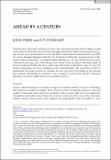Files in this item
Ahead by a century
Item metadata
| dc.contributor.author | Perry, John | |
| dc.contributor.author | Everhart, D.T. | |
| dc.date.accessioned | 2023-11-21T10:30:01Z | |
| dc.date.available | 2023-11-21T10:30:01Z | |
| dc.date.issued | 2023-11-17 | |
| dc.identifier | 295553863 | |
| dc.identifier | f3a1ae3b-7123-4aa3-9d8d-54eacaca3227 | |
| dc.identifier | 85176783379 | |
| dc.identifier.citation | Perry , J & Everhart , D T 2023 , ' Ahead by a century ' , Modern Theology , vol. Early View . https://doi.org/10.1111/moth.12908 | en |
| dc.identifier.issn | 0266-7177 | |
| dc.identifier.uri | https://hdl.handle.net/10023/28734 | |
| dc.description.abstract | Paul Tyson's A Christian Theology of Science has convinced me that David Hume would not be able to affirm the Nicene Creed, though admittedly I didn't need much convincing. In fact, Tyson persuaded me of nearly all his claims about matters before, say, 1922. It is not as though I disagree with the rest, but that in telling the sweeping story of theology's fate in modernity—on which I agree with Tyson—he cuts off his story too soon: a hundred years ago, just when things were about to get exciting in theology again. If he had continued telling the story until today, his book would likely come to very different conclusions; my own conclusions, not coincidentally.1 My plan here is first, to summarize the book, second, to continue Tyson's own story but filling in the missing last century, and finally, to consider a few examples to show how Tyson's Christian theology of science could cash out in scientific practice. | |
| dc.format.extent | 14 | |
| dc.format.extent | 107566 | |
| dc.language.iso | eng | |
| dc.relation.ispartof | Modern Theology | en |
| dc.subject | BL Religion | en |
| dc.subject.lcc | BL | en |
| dc.title | Ahead by a century | en |
| dc.type | Journal item | en |
| dc.contributor.institution | University of St Andrews. School of Divinity | en |
| dc.identifier.doi | https://doi.org/10.1111/moth.12908 | |
| dc.description.status | Peer reviewed | en |
This item appears in the following Collection(s)
Items in the St Andrews Research Repository are protected by copyright, with all rights reserved, unless otherwise indicated.

